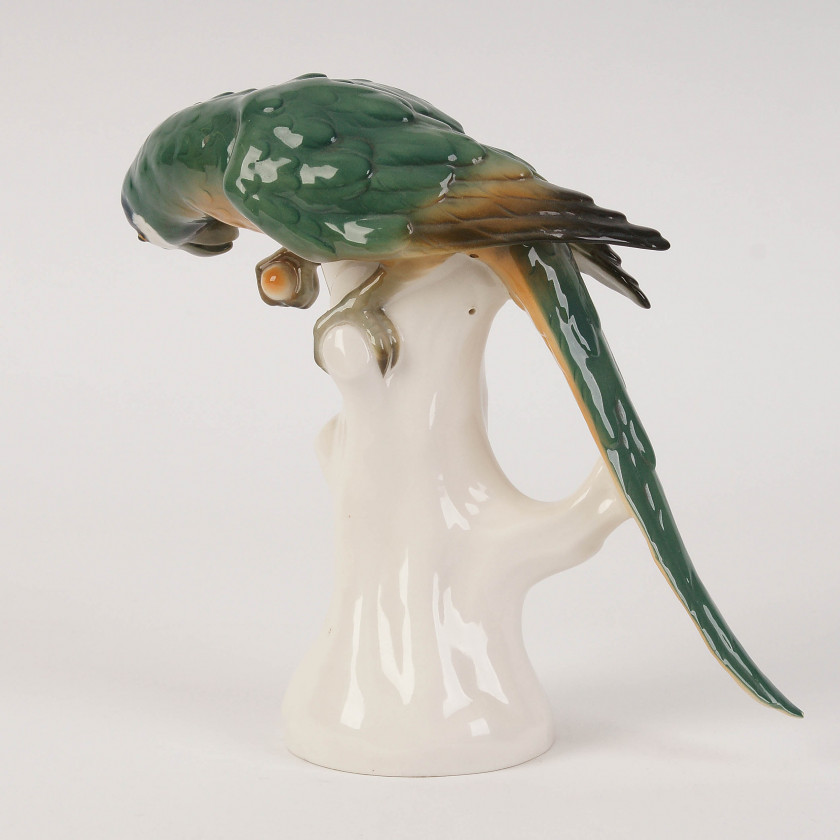Porcelain figure "Parrot"
-
600.00 EUR
Artist/Maker: Aelteste Volkstedter Porzellanmanufaktur
Artist/Maker Dates: 1762 - present
Place of Production: Germany
Date of Production: 1909 - 1936
Materials: porcelain, underglaze hand painting
Height: 19.0 cm.
Condition:
Description
"Aelteste Volkstedter Porcellanmanufakture, Unterwiessbach"
In 1882 Hermann Jost founded the porcelain Porzellanfabrik Unterweißbach. First, only plates and kitchenware were produced. A constant rise in quality was achieved as more and more skilled workers were employed and so the range of products was also growing. During 1890 the company was bought by Rudolf Mann for 30,000 Marks and two years later businessman Fritz Porzelius joined the company as associate. During the next few years the company had a strong economic upturn and in 1899 the company was changed into a joint-stock company, resulting in the name change including the addition.
The names used during this time can be pretty confusing. Officially it was the Porzellanfabrik Unterweißbach A.G., but it sometimes appears with an addition like Mann & Porzelius in advertisements or letter heads, a completely legit way of using the reputation created by the former proprietors for marketing purposes. Shortly after the company was changed into a stock corporation it confusingly also merged with the Aelteste Volkstedter factory from Volkstedt and the name for this group was the infamously long and confusing Aelteste Volkstedter Porzellanmanufaktur und Porzellanfabrik Unterweißbach vormals Mann & Porzelius A.G., the longest German company name I have met so far.
In 1908 Max Adolf Pfeiffer integrated his Schwarzburger Werkstätten für Porzellankunst into the corporation as a stand-alone department using own marks (for example the 'running fox'). As member of the Deutscher Werkbund, a group believing in a thesis of aesthetic modernization through a combination of craftsmen and industrial production, Pfeiffer united both artistic and manufacturing parties. A year later Pfeiffer fully realized the project as a part of the proposed reforms in the educational and applied arts. This idea resulted in cooperations with many famous artists of that time including Ernst Barlach, Max Esser, Paul Scheurich, Gerhard Marcks and Etha Richter.
During the last years, more and more porcelain manufacturers had opened in the area. Companies went through takeovers and alliances to survive and so during 1909, the Aelteste Volkstedter Porzellanmanufaktur in Volkstedt and the former Mann & Porzelius A.G. which in the meantime was only named Porzellanfabrik Unterweißbach, formed a union. A quite interesting fact is that the Aelteste from 1899 onwards had been a joint-stock company for only two years when the Unterweißbach Mann und Porzelius A.G., which was also transformed into a joint-stock company the same year became major share holder.
Some sources even indicate that the Aelteste already was bankrupt in 1901 and had been taken over by Mann & Porzelius, but was run as an independent branch until 1909. This is not mentioned in an original booklet from the Aelteste, but can be found in an original booklet from Unterweissbach. In 1910 the main office of the Unterweißbach factory was moved to Volkstedt and the name was changed to Aelteste Volkstedter Porzellanmanufaktur und Porzellanfabrik Unterweißbach vormals Mann und Porzelius A.G..
In 1910 the Unterweissbach factory received a gold medal at the Brussels World Exposition and a silver medal at the International Hunting Exhibition in Vienna, followed by medals and prizes awarded at the Turin exhibition in 1911 and the year 1913 brought them gold medals in Leipzig and Geneva. During 1913, Max Adolf Pfeiffer also retired as manager of the Schwarzburger Werkstätten and joined the porcelain factory in Meissen. The year 1915 saw the company receive another medal at the Baltic Exhibition. This very lucrative phase was based mostly on the work of Doctor Edmund Troester, the Director of the Aelteste Volkstedter Porzellanmanufaktur between 1908 and 1931.
But
history had a bad surprise up its sleeve. As a consequence of the World
Financial Crisis (from 1929 until around 1933) the company had to file
for bankruptcy and the 'Porzellanfabrik Unterweißbach' was split out of
the assets and the Aelteste continued business as Staatliche
Porzellanmanufaktur Thüringen. Karl Saar owned the factory from 1936
onwards, but he already passed away in 1940; the factory was quickly
taken over by Heinz Schaubach, who already owned the well-known factory
in Wallendorf.
Shipping details
- Log in to see the cost for shipping this lot to your address.
Shipping methods are determined by item size, type, fragility and specific characteristics.
Shipping costs are calculated based on carrier rates, delivery distance and packing complexity.
Payment details
Doma Antikvariāts accepts the following payment methods:







